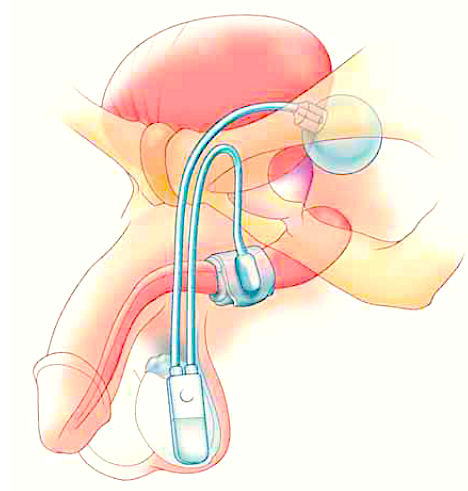Several types of incontinence and pelvic support devices may be encountered in the MRI setting: pessaries (used only by women), penile clamps (used only by men), and sling systems, urethral compression devices and artificial urinary sphincters (used by men and women).
Pessaries
 Silicone and silicone/metal pessaries available from CooperSurgical.
Silicone and silicone/metal pessaries available from CooperSurgical.
Pessaries are silicone or silcone+metal devices placed in the vagina for uterine prolapse and urinary incontinence. Although the use of pessaries has decreased significantly over the last few decades in favor of surgical options, they are still occasionally encountered in MR screening.
Pure silicone pessaries are of course MR Safe but those made of metal covered with silicone are considered MR Unsafe due to concerns about heating. Most have not been rigorously tested using ASTM methods, however, so the unsafe designation is likely out of caution. Although some of these devices can be taken out by the patient, many can only be removed by a health care professional. If in doubt about the composition and whether the device should be removed before scanning, an x-ray of the pelvis will show if a metal substructure is present.
Pure silicone pessaries are of course MR Safe but those made of metal covered with silicone are considered MR Unsafe due to concerns about heating. Most have not been rigorously tested using ASTM methods, however, so the unsafe designation is likely out of caution. Although some of these devices can be taken out by the patient, many can only be removed by a health care professional. If in doubt about the composition and whether the device should be removed before scanning, an x-ray of the pelvis will show if a metal substructure is present.
Penile Clamps
 "MR Unsafe" Penis Clamp
"MR Unsafe" Penis Clamp
Penile clamps, also known as incontinence clamps or urinary cuffs, are widely available without a prescription over the counter and on-line. Although most are made of plastic, rubber, and/or foam, a number of models (including the Squeezer Klip, Uriclak, Cunningham, and J Clamp) contain steel and thus should be removed prior to MRI.
Incontinence Sling Systems
Slings made of autologous fascia or polypropylene mesh are sometimes surgically implanted to elevate the urethra and bladder base as a treatment for incontinence. All are MR Safe, with only the historic InVance™ System (AMS) being "trivially" MR Conditional because it relies on fixation to the pelvis with titanium screws.
Urethral Compression Devices
Another strategy to mitigate urinary incontinence is to implant adjustable balloons partially around the urethra near the bladder neck. Two systems are in common use and are both considered technically MR Conditional because they contain small silicone-coated titanium injection ports in the scrotum:
|
Artificial Urinary Sphincters
|
Now nearly 40 years old, the AMS 800™ Urinary Control System by Boston Scientific is still the most widely used artificial urinary sphincter in the world. A cuff surrounds the urethra which can be filled or emptied of fluid from a pressure-regulating reservoir by the patient squeezing a pump in his scrotum. Although nearly completely made of silicone, the pump mechanism contains valves with tiny metal springs, it is considered MR Conditional with only minimal constraints.
Other artificial sphincters include the ZSI 375® (Zephyr Surgical Implants), the Victo® and Victo+® (Promedon), and the FlowSecure® (RBM-Med). Like the AMS 800, all are hydraulic in nature with some titanium springs or fittings also making them MR Conditional. |
Advanced Discussion (show/hide)»
No supplementary material yet. Check back soon!
References
CooperSurgical. Milex® pessary reference guide. www.coopersurgical.com, downloaded 1/1/21.
Chung E. Contemporary surgical devices for male stress urinary incontinence: a review of technological advances in current continence surgery. Transl Androl Urol 2017; 6(Suppl 2):S112-S121. [DOI LINK]
Mathew RP, Sam M, Alexander T, et al. Abdominal and pelvic radiographs of medical devices and materials- part 2: neurologic and genitourinary devices and materials. Diagn Interv Radiol 2020; 26:160–167 [DOI LINK]
CooperSurgical. Milex® pessary reference guide. www.coopersurgical.com, downloaded 1/1/21.
Chung E. Contemporary surgical devices for male stress urinary incontinence: a review of technological advances in current continence surgery. Transl Androl Urol 2017; 6(Suppl 2):S112-S121. [DOI LINK]
Mathew RP, Sam M, Alexander T, et al. Abdominal and pelvic radiographs of medical devices and materials- part 2: neurologic and genitourinary devices and materials. Diagn Interv Radiol 2020; 26:160–167 [DOI LINK]
Related Questions
How about other GU devices like nephrostomy tubes and stents?
How about other GU devices like nephrostomy tubes and stents?


